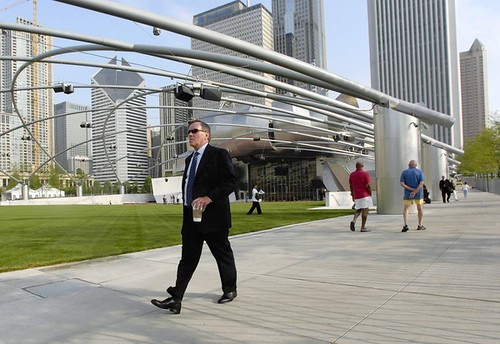On the end of the mayoralty of Richard Daley, Mayor of Chicago

Mayor Richard Daley tours Millennium Park the morning of the grand opening, the first time the park was open to the public. Chicago Tribune photo, July 16, 2004.
For 22 years, Richard Daley has been the Mayor of Chicago. In "A mayor who left his mark on Chicago's cityscape: Love him or hate him, Daley made no little plans," the Chicago Tribune's architecture critic gives his assessment. (Also see "For Daley, democracy in doses," "Will Chicago think big after Daley?," and "Daley the Builder leaves unfinished business.") As Kamin writes:
Some of Daley's mega-projects, like the Klingon meets Parthenon mismatch that is the renovation of Soldier Field, are permanent scars. Others, like Millennium Park, are sheer triumphs.
But whether you hated or loved what Daley was doing, this much never changed: He was always doing something. An "idea a minute" guy, the billionaire Lester Crown called him the other day.
Kamin says these were Daley's shining moments:
•Millennium Park — When Daley looked down on the ugly commuter railroad tracks in the northwest corner of Grant Park from the high-rise office of his dentist in 1997, the wheels for what would become his greatest design triumph started turning. ...
•The Museum Campus — It was one of Daley's predecessors, Jane Byrne, who floated the idea of forming an uninterrupted, pedestrian-friendly green space for Chicago's three natural sciences museums. But it was Daley who actually carried out the heroic urban planning act of shifting northbound lanes of Lake Shore Drive west of Soldier Field, creating a vast greensward between the Field Museum and the Shedd Aquarium.
The 1998 opening of the Museum Campus taught a broader lesson: If we want to move highways to create more humane cityscapes, we possess both the ability and the artistry to do so.
•The Greening of Chicago — Early in his tenure, Daley was a kind of Martha Stewart, prettying up the cityscape with trees and flowers. But he grew beyond being a mere beautifier and became a leading advocate of greening cities to combat global warming. According to city officials, he oversaw the planting of more than 600,000 trees, the construction of more than 85 miles of landscaped medians and the building of more than 7 million square feet — more than any other city in America — of planted roofs. ...
•Upgrading Infrastructure — Daley didn't just build roads and bridges. He built infrastructure that sought to uplift its surroundings.
From the 1996 revamp of State Street, which turned a cold and colorless bus mall into a pedestrian-friendly streetscape, to the 2002 rebuilding of Wacker Drive, which tweaked the road's configuration to make way for new parkland and a river walk, Daley's transportation projects reminded us that a road or a bridge should be more than a passageway.
•Saving Landmarks — Daley's leadership in one historic preservation crisis was exemplary. In 1996, after aldermen stripped 29 buildings and historic districts, including Ludwig Mies van der Rohe's 860-880 North Lake Shore Drive apartments, of temporary landmark status, Daley pushed the City Council to safeguard 28 of the threatened sites. Subsequently, the Cook County Board enacted a package of property-tax breaks for owners of landmark buildings.
But there were failures, including the rebuilding of Soldier Field, and its loss of status as a national historic landmark, and the parking meter lease deal, as well as mixed results on a number of fronts.
Still, just Millennium Park alone is a major triumph that is rare amongst American cities.
WGN-TV, the Chicago-based superstation available on many cable and satellite television systems, has a special on Daley, "Make no Little Plans," this Saturday, May 14th, at 10:30pm Eastern Time.
Labels: change-innovation-transformation, leadership-vision, management of cities, municipal government, provision of public services, urban design/placemaking, urban revitalization



0 Comments:
Post a Comment
<< Home